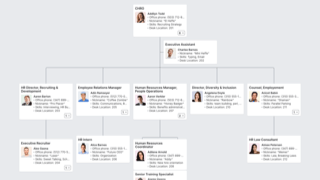Human Resources Organizational Chart Example
We’ve put together an example org chart for Human Resources departments that illustrates the main departments and their most common roles. Check out the interactive org chart below to see just one example of how to organize the essential departments, roles, and skills of your Human Resources employees.
Build Your Org ChartReady to get started?
Download the Human Resources org chart template above, add your own employee data, and Import into Pingboard. Note: you’ll need a Pingboard account first. Sign up for a free trial.
Pro Tip You can build your org chart automatically. Instead of filling out a spreadsheet, you can connect your HR system to Pingboard to automatically sync employee data. Your org chart will get updated automatically every time a change happens. We integrate with ADP, Azure, BambooHR, Google Apps, Namely, Okta, and more.
HR Hierarchy & Most Common Roles
Here’s a quick overview of a typical HR department hierarchy and the job descriptions of those roles:
CHRO | Chief Human Resources Officer
The head of HR departments, whether that is the VP of Human Resources, Chief People Officer, or the CHRO, reports to the CEO, or company owner, and is typically included in the executive team. The head of the HR department determines a company’s strategy for recruiting, employee engagement, and instilling company culture. CHROs are expected to implement strategies that lead their company toward profitability and growth, so their policies should be cost-conscious and focus on expansion. Those are the general responsibilities of CHROs, and here are a few tasks that are commonly assigned to them.
- Partner with department managers in forecasting and planning their talent pipeline requirements in line with the function or business
- Provide expert advice and coaching to leaders and employees regarding human capital trends and management styles
- Lead the HR department in employee performance analysis, identification of skill gaps, and creation of strategies from those analyses to cultivate talent and improve performance at all levels of the business
- Define and monitor relevant workforce metrics, ROI, and KPIs to proactively diagnose and address employment and operational related trends
- Serve as the corporate liaison to advise and consult on cross-functional policies and processes, and to facilitate relevant internal communication to employees, managers, and departments
HR Director, Recruiting & Development
The HR Director carries out policies, processes and procedures relating to full life-cycle human resources. Simply, HR leaders in this space are responsible for recruiting, retaining and enhancing employee performance. That’s the HR Director’s role from a general perspective, but here are a few more specific tasks:
- Coordinate and administer the recruitment, hiring, and termination processes (e.g. advertise vacancies, screen applicants, conduct interviews, make recommendations for new hires, and direct processes for new employee orientation, etc.) for the purpose of maintaining a highly qualified staff
- Guide management and employee actions by researching, developing, writing, and updating policies, procedures, methods, and guidelines, and then communicating and enforcing organizational values
- Develop and monitor an annual budget that includes payroll, human resources services, professional development, and administration
- Lead new initiatives in management development and change
- Develop and administer multiple employee engagement surveys across the workforce to understand staff satisfaction
Human Resources Manager, People Operations
The Human Resources Manager implements the strategies that the CHRO and Director have outlined. They are typically responsible for running important but time-consuming tasks like benefits, onboarding, and other compliance requirements. Because these roles touch a wide variety of HR projects, people in this role are also known as HR generalists. Here are a few specific tasks that HR managers take on:
- Manage benefits administration, including Open Enrollment, claims resolution and communicating benefits information to employees
- Track progress towards HR goals and ensure timely delivery of monthly, quarterly and annual goals.
- Oversee the day-to-day administration of healthcare programs to include 401k retirement plan, medical/dental/ vision, short-term disability, long-term disability, COBRA, etc.
- Manage the accuracy of all employee change status records, in employee directory or HRIS system
- Drive process optimization, partnering with HR stakeholders to understand current process inefficiencies and use data and critical thinking to evaluate scalable solutions
Human Resources Coordinator
This role provides administrative and clerical support for the Human Resource Department. Responsibilities include general reception of applicants and associates and typing up reports, memos, and general correspondence. Someone in this entry-level role would typically help where needed in recruiting, workforce metrics reporting, and development of internal training materials. Here are a few more specific tasks commonly found in HR Coordinator job descriptions:
- Welcome new team members upon their arrival and facilitate new hire orientation
- Support talent acquisition efforts through attending job/career fairs, phone screening of candidates, scheduling interviews, or interviewing candidates
- Assist employees with employee-sponsored benefits questions and claims
- Redirect HR-related calls or distribute correspondence to the appropriate person of the team
- Support the recruitment/hiring process by sourcing candidates, performing background checks, assisting in shortlisting, issuing employment contracts, and more
